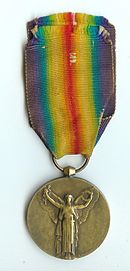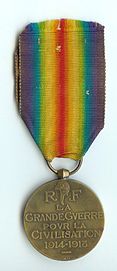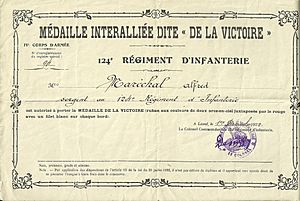1914–1918 Inter-Allied Victory medal facts for kids
Quick facts for kids 1914–1918 Inter-Allied Victory medal (France) |
|
|---|---|
 
Obverse and reverse of the 1914–1918 Inter-Allied Victory medal
|
|
| Type | Commemorative Medal |
| Eligibility | Allied military forces, and attached civilians |
| Awarded for | Participation in World War I |
| Status | No longer awarded |
| Statistics | |
| Established | 20 July 1922 |
| Precedence | |
| Next (higher) | Médaille commémorative du Maroc (1909) |
| Next (lower) | Médaille commémorative de la bataille de Verdun |
| Related | Médaille commémorative de la guerre 1914–1918 |
 Ribbon of the 1914–1918 Inter-Allied Victory medal |
|
The 1914–1918 Inter-Allied Victory medal (in French, "Médaille Interalliée de la Victoire 1914–1918") was a special medal from France. It was created on 20 July 1922. This medal was France's version of a shared award given by many countries that fought together in World War I.
Each country that was part of the Allies made its own Victory Medal. But they all had some things in common. For example, they all used the same ribbon design. The front of each medal showed a winged figure of victory. The back had a similar message. The French medal's message said: "LA GRANDE GVERRE POUR LA CIVILISATION 1914-1918" (The Great War for Civilization 1914-1918).
This medal was given to soldiers who served for at least three months. Their service had to be between 2 August 1914 and 11 November 1918, in the war zone. It was also given to civilian nurses and non-French people who worked directly for the French army. Even high-ranking military leaders like marshals and generals could get it if they led for at least three months. Prisoners of war from Alsace and Lorraine who later joined the French forces also received it.
The rules for the medal also said it could be given to soldiers who died fighting. It was also for those who died from war injuries or illnesses they got while serving. If a soldier passed away, their family had to buy the medal themselves.
After World War I, a French military leader named Ferdinand Foch had an idea. He was the top commander for all the Allied forces. He suggested that most Allied nations should create a similar Victory Medal. This way, countries would not need to swap their own war medals.
Each country made its own medal, but they followed some shared rules. The medal had to be made of bronze and be about 36 millimeters wide. The front of the medal featured a winged figure of victory. The back had a common message. The medal hung from a ribbon designed with a double rainbow pattern.
However, some countries like Japan and Siam (now Thailand) changed the design a bit. They did not use the winged victory figure. This was because a winged victory symbol did not fit their culture.
Here is a list of some of the countries that awarded their own versions of the Victory Medal:
| Country | Designer | Manufacturer | Number issued |
|---|---|---|---|
| Belgium | Paul Du Bois (1859–1938) | Médailles d'Art Fonson & Cie | 300,000 – 350,000 |
| Brazil | Jorge Soubre (1890–1934) |
|
approximately 2,500 |
| Cuba | Charles Charles |
|
6,000 – 7,000 |
| Czechoslovakia | Otakar Španiel (1881–1955) |
|
approximately 89,500 |
| France | Pierre-Alexandre Morlon (1878–1951) |
|
approximately 2,000,000 |
| France | Charles Charles |
|
----- |
| France |
|
----- | ----- |
| Great Britain | William McMillan (1887–1977) |
|
5,725,000 plus |
| Greece | Henry-Eugène Nocq (1868–1944) |
|
approximately 200,000 |
| Italy | Gaetano Orsolini (1884–1954) |
|
approximately 2,000,000 |
| Japan | Shoukichi Hata |
|
approximately 700,000 |
| Poland | ... Vlaitov |
|
----- |
| Portugal | João Da Silva (1880–1960) |
|
approximately 100,000 |
| Rumania | ... Kristesko | ----- | approximately 300,000 |
| Siam (Thailand) | Itthithepsan Kritakara (1890–1935) | ----- | approximately 1,500 |
| South Africa | William McMillan (1887–1977) |
|
approximately 75,000 |
| United States | James Earle Fraser (1876–1953) |
|
approximately 2,500,000 |
(Main source: The interallied victory medals of world war I by Alexander J. Laslo, Dorado Publishing, Albuquerque. 1986 Edition )
Award Certificate
Each person who received the medal also got a special paper. This paper, called a certificate, officially confirmed that they had earned the medal. It also showed they had the right to wear it.
See also
- Allied Victory Medal
- French medals for the First World War
- Orient campaign medal: WWI French campaign medal for the Macedonian front
- Marne Medal: WWI French campaign medal for the First and Second Battles of the Marne
- Dardanelles campaign medal: WWI French campaign medal for the Gallipoli campaign


